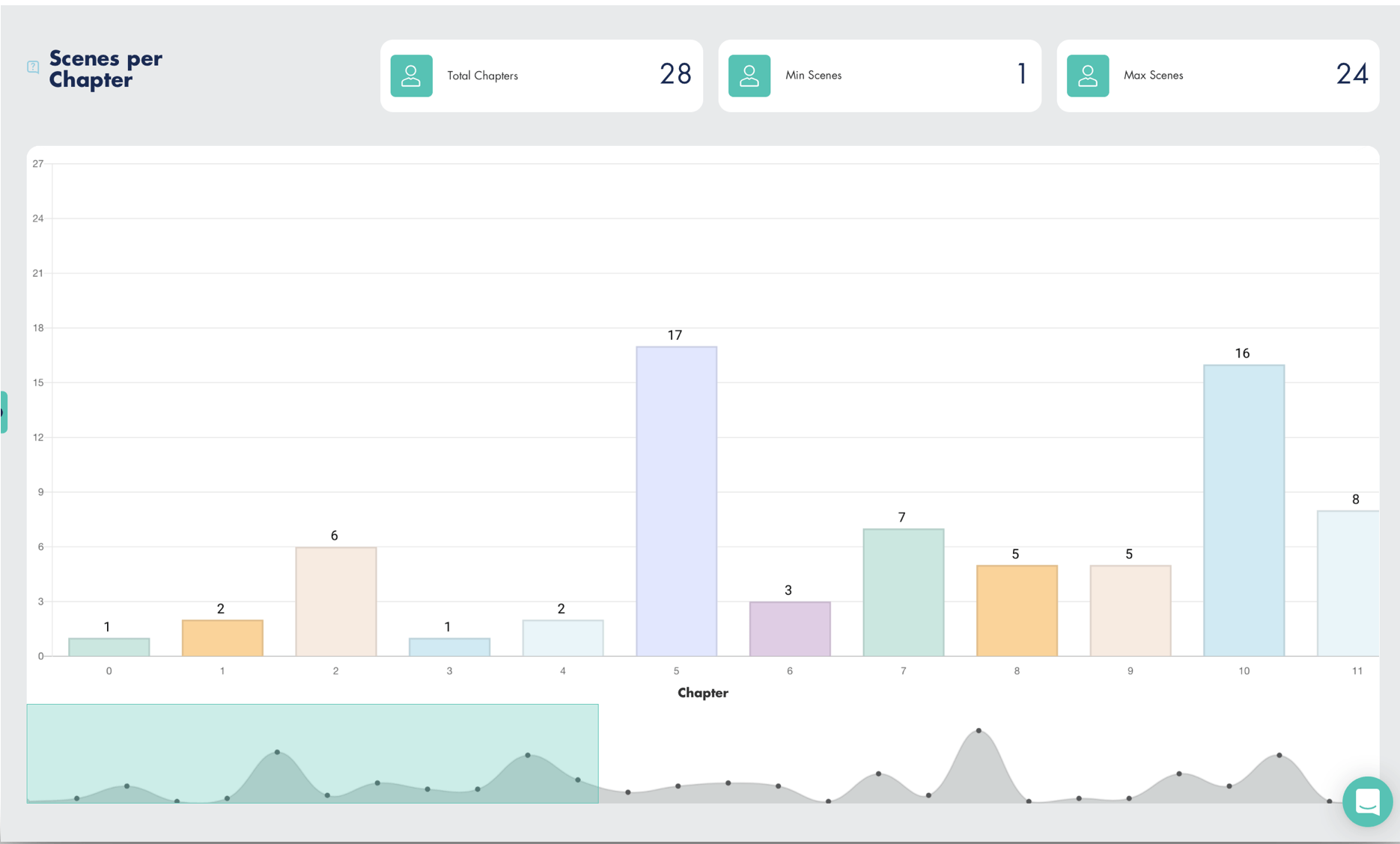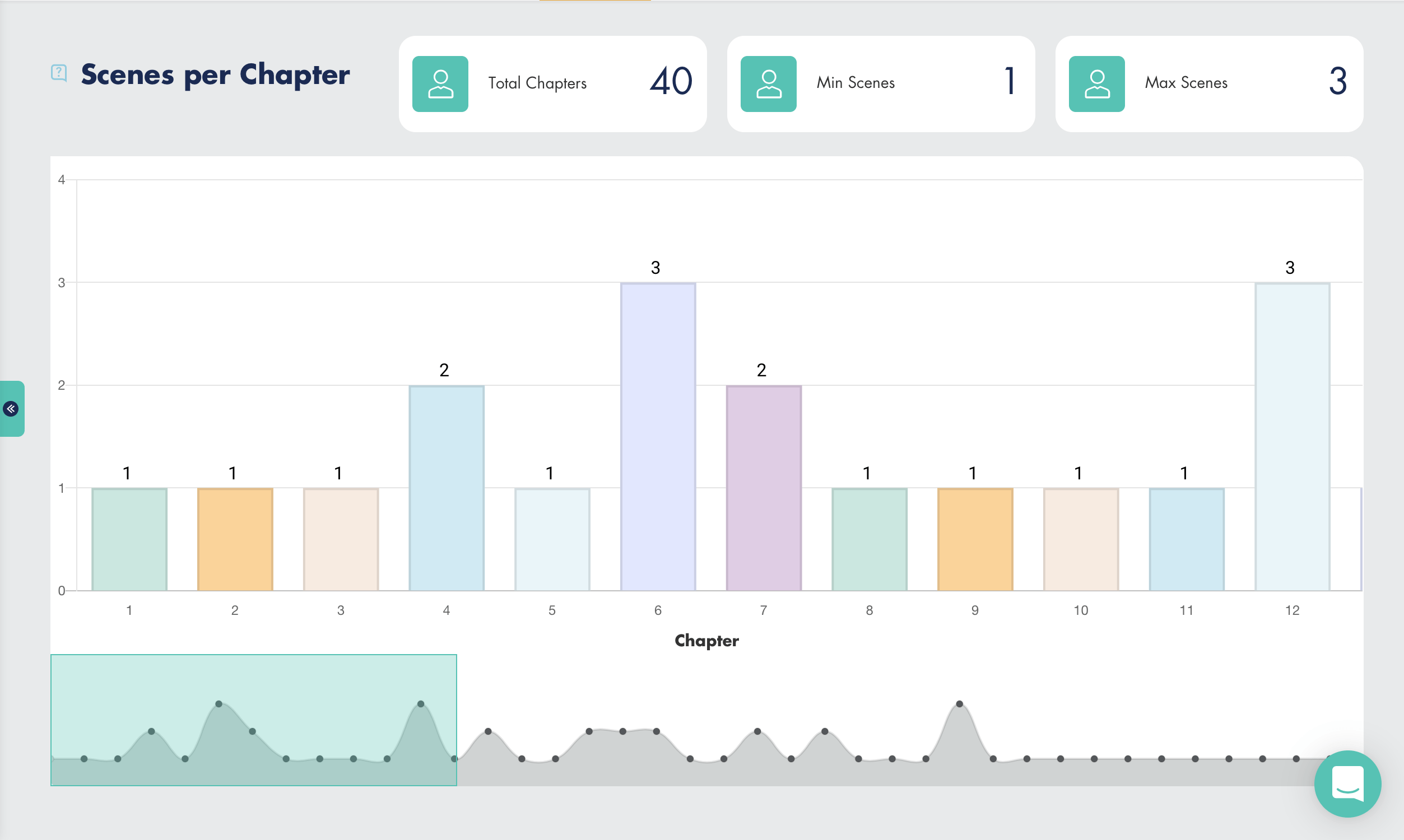How many scenes in a chapter is the right number? And why is that number important?
A scene or several scenes will make up a chapter. The Scenes per Chapter insight in Fictionary automatically illustrates the structure of the novel based on the number of scenes in each chapter.
Take a free trial of Fictionary today and take your story to the next level.
Ok, let’s get started!
An author has two choices. Every chapter can have the same number of scenes, or the number of scenes can vary per chapter throughout the novel.
What Is a Scene?
First, let’s start with the definition of a scene. A scene is a section of a story that contains settings, character, and action. A scene must contain a beginning, a middle, and an end.
What Is a Chapter?
A chapter is a section of a book. Like a scene, it must also contain a beginning, a middle, and an end. A chapter usually consists of two or more scenes.
How Many Scenes Should Be in a Chapter?
Each chapter must contain at least one scene. There is no maximum number of scenes that can be in any chapter.
The number of scenes that should exists in each chapter depends on the genre. A fast-paced crimes may have lots of one scene chapter, for example The Thursday Murder Club.
An epic fantasy may contain ten or more scenes per chapter. Books like The Lord of the Rings need much more contain to convey the story due to the world-buidling.
Between all the genres, the average number of scenes per chapter is three.
How Many Scenes in a Book?
Again, the number of scenes per book totally depends on the genre. But if we are looking at a true average:
- The average length of a novel for adults is 90,000 words.
- The average scene is roughly 1,000 words long.
- So the average number of scenes per novel is 90.
What’s the Purpose of a Scene?
You can use the structure of each chapter to control the pacing of your story.
The longer a chapter, the slower the pacing.
The shorter a chapter, the faster the pacing.
A Similar Number of Scenes per Chapter: An author may choose to write chapters composed of the same number of scenes or a similar number of scenes. She creates a novel in this format, she acquire readers, and the readers come to expect the structure throughout the novel. It might be risky for her to change once she has established a following for her style.
Variable Number of Scenes Per Chapter: You must have at least one scene per chapter. It may only be one word or one sentence, but it still counts as a scene. The upper limit is endless. Sort of…
Potential pitfalls
Too Many Scenes
Suppose there exists one chapter with a greater number of scenes than the others. When the reader gets to this chapter, he’s going to wonder why the writer allocated so much time to the chapter. Either the writer didn’t notice one chapter was way too long, or she did it on purpose because something very important was happening in the scene.
Here’s an example of the Scenes Per Chapter insight shown in Fictionary. The insight draws within seconds of the manuscript being imported. As an editor, it’s one of the first insights I review. It tells me if the writer has control of the structure of the story and where to look for problems if the pacing isn’t right.

The number of scenes per chapter varied quite a bit in the novel shown above. The Scenes per Chapter insight in Fictionary shows the minimum number of scenes in a chapter is 1, and the maximum number of scenes in a chapter is 24. That’s a big range.
Here’s what the reader experiences. The chapters move along quickly, and then they reach chapter 5. It goes on so long the reader has forgotten what happened in chapters 1 to 4. In this case the problem was made worse because chapter 5 was also written from a new character’s point of view which made it seem like a new story had started. By the time, the reader gets back to the original story line, they are no longer invested in the story.
Take a free trial of Fictionary today and take your story to the next level.
Switching Structure of a Chapter Mid-Novel
Even if the reader doesn’t register the number of scenes per chapter consciously, she may be jarred out of reading if the first half of the novel is written with the same number of scenes per chapter, and then the number changes. If you choose to have the same number of scenes per chapter, then remain consistent throughout the novel.
In this example, the last quarter of the novel contains one scene per chapter versus the first three quarters where the number varied. This made the ending feel rushed.

Word Count per Scene
You can also Evaluate the Pacing of Your Novel Using Word Count per Scene.
Fictionary StoryTeller also draws the Word Count per Scene within seconds of importing a manuscript. As an editor, I evaluate this early the editing process.
Want to compare the word counts of your scenes? Take a free trial of Fictionary StoryTeller today
Take a free trial of Fictionary today and take your story to the next level.
StoryTeller is creative editing software for fiction writers. Transform your story, not just your words. Successful stories depend on your ability to edit, improve, and revise your work. Only when you master story editing, can you master storytelling.
With StoryTeller’s Scenes per Chapter insight, you’ll see the number of scenes in a chapter in seconds. Then you can evaluate the structure of a chapter.
Why not check out Fictionary’s StoryTeller free 7-day trial and tell powerful stories?



